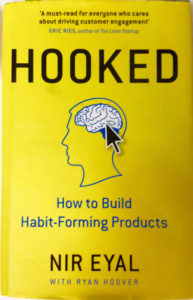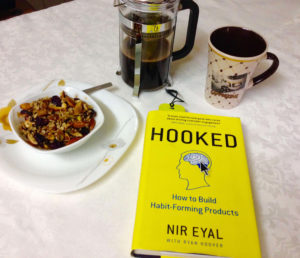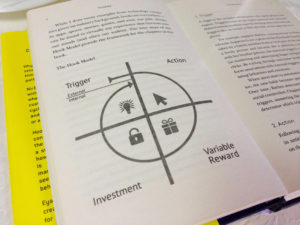Hooked is a delightful read as it exemplifies the combination of exoteric writing style and how companies leverage our impulsive behavior towards the social media to make successful products. It focuses on how products become a part of our lives via habits.
Before we begin, here is one simple question. With the first lights of dawn, what is the first action performed by you? Visiting your Facebook or Twitter or any other social media account? Is it? Ouch! In this case, your vitality has been infected by the social-media syndrome, and it might not be a good sign. Although I am, too, in the same league, but this behavior has compelled me to question my sanity very lately. Let’s admit it; we are hooked.
Have you ever wondered what triggers this unprompted behavior? Why is there an urge to satisfy this itch of checking our social media profiles multiple times in a day? How these behaviors inhabit our brain? Without any notification or a conscientious effort, why is there a sudden craving to click the Facebook icon every time we unlock our phones? The simple answer is: Habit. These automatic behaviors have been so deeply ingrained in our brains and if you plan to count the number of times you open Facebook unconsciously, you will be surprised. And Nir Eyal has brilliantly explained this behavior in his book known as – Hooked.
The scenario these days….
“People do not know what they want until you show it to them.” – Steve Jobs
This famous quote by the legendary Apple-founder and an absolute trailblazer Steve Jobs acts as a springboard whenever I venture into a new endeavor. One of the greatest visionaries and pioneers of the computer revolution, this presumptuous and narcissist leader has inspired me to some extent – though I am not a fan due to several reasons – and this particular quote has always sent me into an abyss of thoughts.
On encountering with this quote for the first time, I remember to have been hit by an epiphany that how the curious element of a human’s brain is always on a quest for new and exciting adventures. And this is what Apple Inc. or Steve Jobs did. He understood the inquisitive personality of humans and gave them something which they might not needed but just wanted to sooth their tingly sensation of curiosity. Along with the product’s features, Steve Jobs also understood the psychology of the people and the missing elements of a smart phone before the iphone era, and this potent combination lead the tech giant, Apple Inc., to usher into a new period of time.
Gone are the days when a product’s features were solely considered for its success or failure. In this universe of constant flux where the progress of digital media, social network, branding, and constantly changing technology have taken imaginary leaps, companies are now infected with the concept of habit-forming products (I have explained this concept in the next section) which leads to a deep connection between a consumer and its product in a sure-fire way. Nir Eyal’s Hooked exemplifies the combination of exoteric writing style and our impulsive behaviors towards the usage of the products in this contemporary world.
The Books’s ethos
Hooked focuses on the concept of habit-forming products, and it has been brilliantly simplified through real-world examples. In terms of definition, a habit is a behavior done with little or no conscious thoughts, and habit-forming products are those which reach the ultimate goal of unprompted user engagement, bringing users back repeatedly without any expensive advertisement strategies. Please note the word “Unprompted”. The engagement of the users with the product is so automatic or impulsive that they do not wait for any external trigger such as notifications or alerts. When a product solves a user’s problem or satisfy their discomfort, users are hooked, and the products are associated with their lives.
Examples – How we get hooked:
There are tons of examples for habit-forming products; however, for simplicity, let’s take an example of Facebook first. Do you wait for any trigger to open this social networking site? Of course not. As I mentioned in the beginning, our unconscious effort to repeatedly check our Facebook account is so automatic that we do not rely on a trigger anymore. Once a product creates such an automatic behavior in terms of its usage, it is classified as a habit-forming product. The reason is that it has successfully created a habit in users’ mind, and they do not need further indication to engage with the product; the notification system which prompts the user to check the Facebook account has been usurped by the unconscious effort.
Zomato is a platform which provides detailed and valuable information about restaurants. Before its inception, my husband and I had no means of going through the menu of a restaurant. Being vegetarians, we always like to check the diversity of the food menu before we visit a restaurant, and the inability to do so vexed us for a long time. However, the advent of Zomato was a boon to us as it became relatively simple to pick a restaurant of our choice by checking their menu online. Zomato gave us the exact solution we were looking for; hence, it became a habit-driven product for us, and we were hooked.
Another quintessential example of a habit-driven product is Google. As a result of the increasing popularity and the extreme dominance of this search engine, the term Google has been awarded the status of a verb. We have shortened the phrase from “Let’s search this on Google” to “let’s Google it”. There are other search engines available which will give you similar results; however, in case you are hooked to Google from a very long time, would you like to switch to any other search engine? May be or may be not.
The results given by Yahoo’s Bing are nearly identical, so why haven’t most of the Google users switched to Bing? The simple answer is that Google has become a part of our lives; in short, a habit. Users no longer need to think about whether or not to use Google; they just do. This is a habit-driven behavior resulting in Google’s market domination, and it is almost impossible to alter this behavior because habits keep users loyal.
The author’s comparison of these behaviors to painkillers and vitamins piqued my curiosity. He mentions:
“Are you building a vitamin or a painkiller?” is a common , almost cliched question many investors ask founders eager to cash their first venture capital check. Painkillers solve an obvious need, reliving a specific pain, and often have quantifiable markets. Vitamins, by contrast, do not necessarily solve an obvious pain point. Instead, they appeal to user’s emotional rather than functional needs. Habit-forming technologies are both. These services seems at first to be offering nice-to-have vitamins, but once the habit is established, they provide an ongoing pain remedy.
In reality, the experience we are talking about is more similar to an itch, a feeling that manifests within the mind and causes discomfort until it is satisfied. The habit- forming products we use are simply there to provide some sort of psychological relief. The ultimate goal of these products is to solve the user’s pain by creating an association so that the user identifies the company’s product or service as a source of relief.
Key takeaway from the book – How to build habit-forming products?
One of my favorite aspects from the book is the section where the author brilliantly explains the process of building a habit-forming product via The Hook Model which stems from his distilled research and real-world experience, Here are the four phases of the Hook model:
Phase 1 – Trigger:
A trigger is a cue or a spark which activates the behavior. Triggers come in two types: external and internal. Habit-forming products start with external triggers such as notifications or alerts on your phones. These triggers are embedded with information, guiding the user about the next steps. On the other hand, an internal trigger is tightly coupled with an emotion, a thought, or a pre-existing routine, and these triggers manifest automatically in your mind. Emotions, negative or positive, play a vital role in internal triggers.
For instance: A girl named Yin was emotionally connected with Instagram due to her fear of losing a special moment forever. In her case, when the associations were formed using the external triggers, her emotions or the attachment with the app created an internal trigger; thus creating a habit to use Instagram whenever there is a special moment in her day. As a result, there was no need for external trigger anymore. Yes, she was hooked.
The objective is to start with external triggers, and once an emotional relationship has been formed between a user and its product, the internal trigger manifests in the mind; hence, creating an automatic behavior or a habit.
Phase 2 – Action:
Once a trigger has been activated, which informs the user of what to do next, an action is required. Without a scintilla of doubt, this step is paramount to habit formation. An action occurs when motivation, ability, and trigger are present at the same time and in sufficient degrees. These three elements are extremely important for an action to occur, and the absence of any one of them can lead to inactivity.
In the same example: When Yin gets an alert to check a like or a comment on Instagram, the notification indicates her to reply to the comment. However, if her phone was buried in a bag and therefore difficult to reach then her inability to easily reply can inhibit the action. Or, she might have thought that it was a message from a telemarketer or someone else she did not want to speak to; again, her lack of motivation can lead to inaction. Lastly, in case she was anticipating a trigger and her phone was within reach, but the inability to hear the alert or notification or trigger can also lead to inaction.
Phase 3 – Variable Reward:
Ultimately, we all look forward to a reward in an action, and this is the satisfaction we crave. Via rewards, users come to depend on the product as a: reliable solution to their problem or a relief from a psychological itch. It is important to note the term “Variable” here. The rewards have to be variable in order to maintain the curious element in humans. In other words, the same kind of reward on every outcome makes it predictable, and the entire experience becomes less exciting. To hold a user’s attention, products must have an ongoing degree of novelty.
Facebook provides numerous examples of variable rewards. The anticipation of number of likes or comments on statuses or pictures are the biggest social rewards which people crave for in this altered perception of reality.
Phase 4 – Investment:
The last step requires users to put something in the product such as effort, time, data, etc. This is an important phase because its successful execution promises the repetitive behavior, and it increases the odds that the user will make another pass through the Hook cycle in the future. Ultimately, the basic objective of building a product is to provide the repetitive usage so that the user comes back to the product via various cycles of the Hook model.
For example: Inviting friends, following people, stating your preferences, updating your information on LinkedIn periodically, pinning an image on Pinterest etc. epitomize the investment phase where the users dedicate their time and effort to come back to all these products with the anticipation of new rewards. Investment phase helps in determining the trigger for the next cycle. As people invest their time and effort, it is less likely that they leave the product.
At the end…..
We all understand the dark side and the corrosive power of this tech world. However, when harnessed correctly, the technology can enhance lives, make us smarter, and increase our productivity. If you want to know more about how companies understand the psychological trends of the consumers in building the products, Hooked is a delightful read. Its simplicity and numerous real-world examples further enhance the reading experience.
Go for it; I eagerly await your feedback.
Note: In the spirit of full disclosure, the link to the book above is an affiliate link, which means that I may get a commission if you decide to purchase the book from Amazon. I only recommend books that I love myself, so I know you will be in good hands.



